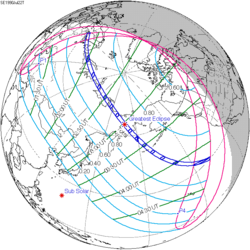Top Qs
Timeline
Chat
Perspective
Solar eclipse of August 31, 1932
Total eclipse From Wikipedia, the free encyclopedia
Remove ads
A total solar eclipse occurred at the Moon's descending node of orbit between Wednesday, August 31 and Thursday, September 1, 1932,[1] with a magnitude of 1.0257. A solar eclipse occurs when the Moon passes between Earth and the Sun, thereby totally or partly obscuring the image of the Sun for a viewer on Earth. A total solar eclipse occurs when the Moon's apparent diameter is larger than the Sun's, blocking all direct sunlight, turning day into darkness. Totality occurs in a narrow path across Earth's surface, with the partial solar eclipse visible over a surrounding region thousands of kilometres wide. Occurring about 3 days before perigee (on September 3, 1932, at 19:40 UTC), the Moon's apparent diameter was smaller.[2]


Totality was visible from Northwest Territories (today's Northwest Territories and Nunavut) and Quebec in Canada, and northeastern Vermont, New Hampshire, southwestern Maine, the northeastern tip of Massachusetts, and northeastern Cape Cod in the United States. A partial eclipse was visible for parts of the eastern Soviet Union (on September 1 local time), North America, Central America, the Caribbean, and northern South America.
Remove ads
Observations
Members of the Royal Astronomical Society of Canada made observations in Maskinongé, Magog, Acton Vale, Sorel-Tracy and Louisville in Quebec. The sky in Quebec was covered in clouds on the morning of August 31. In the afternoon, the clouds gradually dispersed, and observations of totality were successful.[3] In the northeastern United States, scientists also studied the reactions of animals during the eclipse.[4]
Remove ads
Eclipse details
Summarize
Perspective
Shown below are two tables displaying details about this particular solar eclipse. The first table outlines times at which the moon's penumbra or umbra attains the specific parameter, and the second table describes various other parameters pertaining to this eclipse.[5]
Remove ads
Eclipse season
This eclipse is part of an eclipse season, a period, roughly every six months, when eclipses occur. Only two (or occasionally three) eclipse seasons occur each year, and each season lasts about 35 days and repeats just short of six months (173 days) later; thus two full eclipse seasons always occur each year. Either two or three eclipses happen each eclipse season. In the sequence below, each eclipse is separated by a fortnight.
Related eclipses
Eclipses in 1932
- An annular solar eclipse on March 7.
- A partial lunar eclipse on March 22.
- A total solar eclipse on August 31.
- A partial lunar eclipse on September 14.
Metonic
- Preceded by: Solar eclipse of November 12, 1928
- Followed by: Solar eclipse of June 19, 1936
Tzolkinex
- Preceded by: Solar eclipse of July 20, 1925
- Followed by: Solar eclipse of October 12, 1939
Half-Saros
- Preceded by: Lunar eclipse of August 26, 1923
- Followed by: Lunar eclipse of September 5, 1941
Tritos
- Preceded by: Solar eclipse of October 1, 1921
- Followed by: Solar eclipse of August 1, 1943
Solar Saros 124
- Preceded by: Solar eclipse of August 21, 1914
- Followed by: Solar eclipse of September 12, 1950
Inex
- Preceded by: Solar eclipse of September 21, 1903
- Followed by: Solar eclipse of August 11, 1961
Triad
- Preceded by: Solar eclipse of October 30, 1845
- Followed by: Solar eclipse of July 2, 2019
Solar eclipses of 1931–1935
This eclipse is a member of a semester series. An eclipse in a semester series of solar eclipses repeats approximately every 177 days and 4 hours (a semester) at alternating nodes of the Moon's orbit.[6]
The partial solar eclipses on April 18, 1931 and October 11, 1931 occur in the previous lunar year eclipse set, and the solar eclipses on January 5, 1935 (partial), June 30, 1935 (partial), and December 25, 1935 (annular) occur in the next lunar year eclipse set.
Saros 124
This eclipse is a part of Saros series 124, repeating every 18 years, 11 days, and containing 73 events. The series started with a partial solar eclipse on March 6, 1049. It contains total eclipses from June 12, 1211 through September 22, 1968, and a hybrid eclipse on October 3, 1986. There are no annular eclipses in this set. The series ends at member 73 as a partial eclipse on May 11, 2347. Its eclipses are tabulated in three columns; every third eclipse in the same column is one exeligmos apart, so they all cast shadows over approximately the same parts of the Earth.
The longest duration of totality was produced by member 39 at 5 minutes, 46 seconds on May 3, 1734. All eclipses in this series occur at the Moon’s descending node of orbit.[7]
Metonic series
The metonic series repeats eclipses every 19 years (6939.69 days), lasting about 5 cycles. Eclipses occur in nearly the same calendar date. In addition, the octon subseries repeats 1/5 of that or every 3.8 years (1387.94 days). All eclipses in this table occur at the Moon's descending node.
Tritos series
This eclipse is a part of a tritos cycle, repeating at alternating nodes every 135 synodic months (≈ 3986.63 days, or 11 years minus 1 month). Their appearance and longitude are irregular due to a lack of synchronization with the anomalistic month (period of perigee), but groupings of 3 tritos cycles (≈ 33 years minus 3 months) come close (≈ 434.044 anomalistic months), so eclipses are similar in these groupings.
Inex series
This eclipse is a part of the long period inex cycle, repeating at alternating nodes, every 358 synodic months (≈ 10,571.95 days, or 29 years minus 20 days). Their appearance and longitude are irregular due to a lack of synchronization with the anomalistic month (period of perigee). However, groupings of 3 inex cycles (≈ 87 years minus 2 months) comes close (≈ 1,151.02 anomalistic months), so eclipses are similar in these groupings.
Remove ads
Notes
References
Wikiwand - on
Seamless Wikipedia browsing. On steroids.
Remove ads






































































































